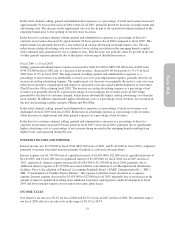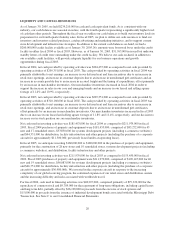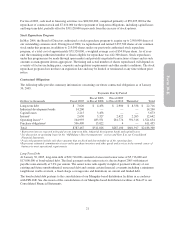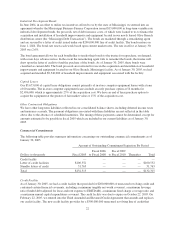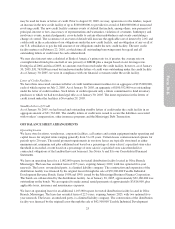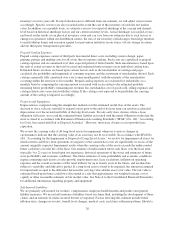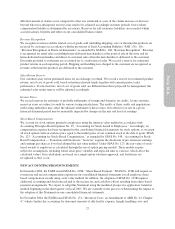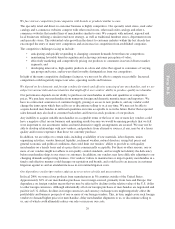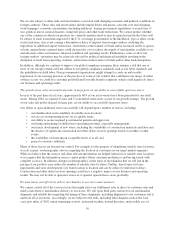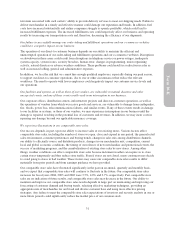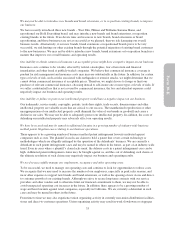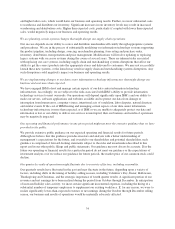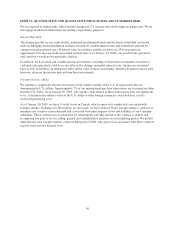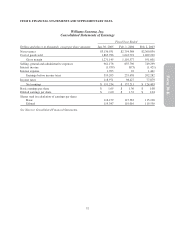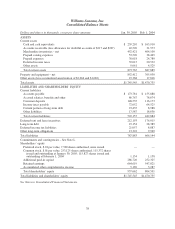Pottery Barn 2004 Annual Report Download - page 35
Download and view the complete annual report
Please find page 35 of the 2004 Pottery Barn annual report below. You can navigate through the pages in the report by either clicking on the pages listed below, or by using the keyword search tool below to find specific information within the annual report.spoilage. We are required to adopt the provisions of SFAS No. 151 effective January 30, 2006, however, early
adoption is permitted. We do not expect the adoption of this Statement to have a material impact on our
consolidated financial position, results of operations or cash flows.
In December 2004, the FASB issued SFAS No. 153, “Exchange of Non-Monetary Assets – An Amendment of
ARB Opinion No. 29,” which requires non-monetary asset exchanges to be accounted for at fair value. We are
required to adopt the provisions of SFAS No. 153 effective January 30, 2006, however, early adoption is
permitted. We do not expect the adoption of this Statement to have a material impact on our consolidated
financial position, results of operations or cash flows.
RISK FACTORS
The following information describes certain significant risks and uncertainties inherent in our business. You
should carefully consider such risks and uncertainties, together with the other information contained in this
Annual Report on Form 10-K and in our other public filings. If any of such risks and uncertainties actually
occurs, our business, financial condition or operating results could differ materially from the plans, projections
and other forward-looking statements included in the section titled “Management’s Discussion and Analysis of
Financial Condition and Results of Operations” and elsewhere in this report and in our other public filings. In
addition, if any of the following risks and uncertainties, or if any other disclosed risks and uncertainties, actually
occurs, our business, financial condition or operating results could be harmed substantially, which could cause
the market price of our stock to decline, perhaps significantly.
We must successfully anticipate changing consumer preferences and buying trends, and manage our inventory
commensurate with customer demand.
Our success depends upon our ability to anticipate and respond in a timely manner to changing merchandise
trends and customer demands. Consumer preferences cannot be predicted with certainty and may change between
sales seasons. Changes in customer preferences and buying trends may also affect our brands differently. If we
misjudge either the market for our merchandise or our customers’ purchasing habits, our sales may decline
significantly, and we may be required to mark down certain products to sell the resulting excess inventory or to
sell such inventory through our outlet stores or other liquidation channels at prices which are significantly lower
than our retail prices, each of which would negatively impact our business and operating results.
In addition, we must manage our inventory effectively and commensurate with customer demand. Much of our
inventory is sourced from vendors located outside the U.S. Thus, we usually must order merchandise, and enter
into contracts for the purchase and manufacture of such merchandise, well in advance of the applicable selling
season and frequently before trends are known. The extended lead times for many of our purchases may make it
difficult for us to respond rapidly to new or changing trends. Our vendors may also not have the capacity to
handle our demands. In addition, the seasonal nature of the specialty home products business requires us to carry
a significant amount of inventory prior to peak selling season. As a result, we are vulnerable to demand and
pricing shifts and to misjudgments in the selection and timing of merchandise purchases. If we do not accurately
predict our customers’ preferences and acceptance levels of our products, our inventory levels will not be
appropriate, and our business and operating results may be negatively impacted.
Our business depends, in part, on factors affecting consumer spending that are out of our control.
Our business depends on consumer demand for our products and, consequently, is sensitive to a number of
factors that influence consumer spending, including general economic conditions, disposable consumer income,
fuel prices, recession and fears of recession, war and fears of war, inclement weather, consumer debt, interest
rates, sales tax rates and rate increases, consumer confidence in future economic conditions and political
conditions, and consumer perceptions of personal well-being and security. These factors may also affect our
various brands and channels differently. Adverse changes in factors affecting discretionary consumer spending
could reduce consumer demand for our products, thus reducing our sales and negatively impacting our business
and operating results.
28



